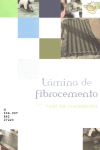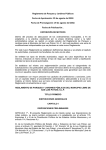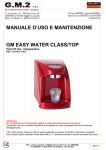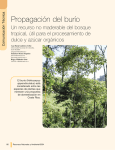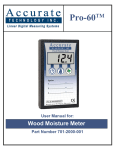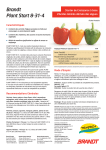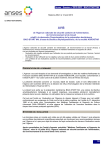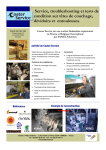Download ÉPOCAS DE COLECTA Y TRATAMIENTOS PARA
Transcript
ÉPOCAS DE COLECTA Y TRATAMIENTOS PARA ENRAIZAMIENTO DE ESTACAS DE CIRIMO Tilia mexicana Schlecht. (Tiliaceae) HARVEST SEASONS AND TREATMENTS FOR THE ROOTING OF GRAFTS OF Tilia mexicana Schlecht. (Tiliaceae) H. Jesús Muñoz Flores 1, Gabriela Orozco Gutiérrez 1, Jesús García Magaña2, Víctor Manuel Coria Avalos 1, Rafael Salgado Garciglia3 y María del Rocío Santiago Santiago4 RESUMEN Tilia mexicana es una especie en peligro de extinción, por lo que es necesario desarrollar métodos de reproducción que aseguren su supervivencia. Los objetivos del presente estudio fueron propagar asexualmente, así como evaluar el efecto de diferentes épocas de colecta, la longitud y diámetro de estacas en la emisión de raíces, mediante AIB. En el material de la primera fecha se observó 39.3% del total de tallos enraizados. Dado que en tres de los cuatro meses en los que se obtuvieron las estacas, el índice de enraizado fue de 0%, el análisis estadístico sólo se realizó con los datos de septiembre La óptima proliferación de raíces (51.1%) se registró en tallos de 20 cm de longitud y 1.5 cm de diámetro, que formaron 3.06 raíces/estaca de 0.9 cm de longitud con un diámetro promedio de 0.47 cm. Se tuvo diferencia significativa (P>F=0.012) entre los tratamientos para el diámetro de la raíz. Las estacas de mayores dimensiones produjeron raíces más cortas y diámetro más grande, y en las pequeñas se los resultados fueron opuestos. La formación de callo varió con la día de colecta y el tamaño de los propágulos, aunque las del mes de diciembre presentaron el porcentaje más alto (30.1%). La mejor respuesta de enraizamiento ocurrió en las estacas correspondientes a la última etapa del verano, ya que coincide con la emisión de yemas del árbol, es decir, hay un efecto estacional que favorece la capacidad de enraizamiento. Palabras clave: Enraizamiento, estacas, Michoacán, propagación vegetativa, Tilia mexicana, viveros. ABSTRACT The cirimo tree (Tilia mexicana Schlecht.) is an endangered species that is widely used in Michoacán, México. It is necessary to develop effective propagation methods to ensure its survival. The general objective was to propagate cirimo, and the particular objectives was to assess the effect of different collection dates as well as the length and diameter of stem cuttings on the best rooting, using IBA. Root proliferation was observed in the first collection, resulting in 39.3 % of cuttings rooting. Because the rooting percentage was 0% in the subsequent three collections, the statistical analysis was performed for September for the different analyzed variables. The optimal proliferation of roots (51.1 %) was observed in explants of 20 cm length and 1.5 cm diameter, which formed 3.06 roots/cutting of 0.9 cm length with an average diameter of 0.47 cm. There were significant differences (P>F=0.012) among treatments in root diameter. The longest cuttings with high diameter produced shorter roots with the highest diameter, while the smaller cuttings produced the longest roots with smaller diameter. All the four collections resulted in callus formation, but the percentage varied according to the date and the size of the explants, with the cuttings of December collection showing the highest percentage (30.1 %). Best rooting response occurred in cuttings collected during late summer, since it is also the budding season, which might explain the seasonal effect that promotes rooting capacity. Key words: Rooting, stake, Michoacán, vegetative propagation, Tilia mexicana, nurseries. Fecha de recepción: 22 de febrero de 2010 Fecha de aceptación: 22 de febrero de 2011 CE. URUAPAN-CIRPAC-INIFAP. Correo- e: [email protected] UMSNH Instituto de Investigaciones Químico Biológicas. 3 UMSNH Instituto de Investigaciones Químico Biológicas. 4 UMSNH Facultad de Agrobiología. 1 2 Rev. Mex. Cien. For. Vol. 2 Núm. 3 INTRODUCCIÓN INTRODUCTION A nivel mundial, México ocupa el tercer lugar en diversidad biológica (Toledo, 1994); sin embargo, las actividades económicas han desembocado en una acelerada destrucción de sus recursos naturales debido, principalmente, a cambios del uso del suelo (agrícola y pecuario), crecimiento rápido de las zonas urbanas, plagas, enfermedades y de manera importante a los incendios forestales, cuya causa principal siguen siendo el descuido y la negligencia derivados del uso irresponsable del fuego en las actividades agrícolas y pecuarias (Rzedowski, 1992). At a world scale, Mexico is the third country in terms of biological diversity (Toledo, 1994); however, economic activities have led to a fast destruction of natural resources, mainly due to changes in land use (crop and game), accelerated urban-zone growth, plagues, diseases and in a major way, forest fires, whose main cause keeps being carelessness and negligence from the non responsible use of fire for agriculture and game activities (Rzedowski, 1992). Michoacan state is at the fifth place of biodiversity at a national level; in addition, it is an outstanding in handcrafts production, which supports the economy of many towns of the Purhepecha region. Tilia mexicana Schlecht. (“cirimo”) in particular, is a species that is used for furniture, handcrafts and music instruments. The flowers and leaves are used for medicinal purposes. It has been classified as a species at risk of extinction, according to the Official Mexican Regulation SEMARNAT-059-2001 (SEMARNAT, 2002); thus, it is necessary to guarantee its conservation through efficient reproduction methods. Al estado de Michoacán le corresponde, en el ámbito nacional, el quinto lugar en lo que a su biodiversidad se refiere, además se distingue por ser una región sobresaliente en la elaboración de artesanías, la cual sustenta la economía de algunos pueblos de la región Purhépecha. En particular Tilia mexicana Schlecht. (cirimo), es una especie que se usa para fabricar muebles, artesanías e instrumentos musicales. Las flores y las hojas se utilizan como productos medicinales. Se le cataloga en peligro de extinción en la Norma Oficial Mexicana SEMARNAT-059-2001(SEMARNAT, 2002), por ello es necesario asegurar su permanencia mediante métodos de reproducción efectivos. Tilia mexicana has propagation problems, and has been tested with sexual and asexual techniques with poor results; besides this, seed has slow germination due to inhibitors, to water-proof cover, dormancy of the embryo and a resistant pericarp. Some authors state that these types of latency can be overcome by stratification with treatments that include the use of strong acids or through low temperatures (Rodríguez, 1986; García, 1994). Tilia mexicana tiene problemas de propagación, la cual se ha intentado mediante técnicas sexuales y asexuales con poco éxito; además, su semilla es de germinación retardada por la presencia de inhibidores, de una cubierta impermeable, dormancia en el embrión y pericarpio resistente, por lo que algunos autores mencionan que estos tipos de latencia pueden ser superados por medio de escarificación con tratamientos que incluyan el uso de ácidos fuertes o estratificándola a bajas temperaturas (Rodríguez, 1986; García, 1994). Thus, it is necessary to look for other options as the vegetative procedure, that consists in the separation of live organs of the plant and that is used for species that do not produce viable seeds or when they do not germinate due to different factors: latency, dormancy and the presence of inhibitors (Wagner, 1992). The most frequently used methods for forest species are by grafting twigs and shoots. One advantage of asexual plant propagation is the multiplication of the whole genetic information of the parental individual and, thus, the perpetuation of the desired characteristics, with which the genetic uniformity is achieved and that helps to accomplish the establishment of seeding orchards (Hartman and Kester, 1985). Por lo anterior, es necesario buscar otras opciones como la vegetativa, que consiste en separar órganos vivos de la planta, y que se emplea con especies que no producen semilla viable o cuando éstas no germinan por diferentes factores: la latencia, la dormancia y la presencia de inhibidores (Wagner, 1992). Los métodos más usados en especies forestales son por acodo y estacas. Una ventaja de propagar plantas asexualmente es el reproducir toda la información genética del individuo progenitor y con ello perpetuar las características deseadas, con lo cual se logra la uniformidad genética que sirve para el establecimiento de huertos semilleros (Hartman y Kester, 1985). From the situation described above, the following objectives were proposed: to determine the length and diameter of the branch stakes that favor root production, as well as to assess the effect of different collecting dates and an absorption method supplemented by a ro oting formula based on indole-3-butyric acid (IBA). Dada la problemática situación antes planteada, para el presente trabajo se propusieron los siguientes objetivos: determinar la longitud y diámetro de estaca de rama que favorecen la emisión de raíces; así como, evaluar el efecto 14 Muñoz et al., de diferentes fechas de colecta y un método de absorción complementado con un enraizador formulado a base de AIB (ácido indol-3-butírico). MATERIALS AND METHODS The rooting tests were performed in the Barranca del Cupatitzio National Park that extends over a 19.8 ha land; it is located at the northeast of Uruapan city, in Michoacan state, between 19°25’ 05” de North and 102°04´03” West at an altitude from 1,680 to 1,700 m. The original vegetation of the park was a gallery forest, and its native species are Taxodium mucronatum Ten. (sabino or baldcypress), Ficus glaucescens Liebm Miq. (higo or fig), Mussa ensete Gmel. (vástago de hueso), Salix babylonica L. (sauce llorón or weeping willow ) and Fraxinus udhei (Wenz) Ling. (fresno or ash). MATERIALES Y MÉTODOS Las pruebas de enraizamiento se realizaron en el vivero del Parque Nacional Barranca del Cupatitzio, que tiene una superficie de 19.8 ha; se ubica al noroeste de la ciudad de Uruapan, Michoacán, entre los 19°25’ 05” de latitud norte y 102°04´03” longitud oeste, a una altura de 1,680 a 1,700 msnm. De origen el tipo de vegetación del Parque Nacional corresponde a un bosque de galería y las especies nativas son: Taxodium mucrona tum Ten. (sabino), Ficus glaucescens Liebm Miq. (higo), Mussa ensete Gmel. (vástago de hueso), Salix babylonica L. (sauce llorón) y Fraxinus udhei (Wenz) Ling. (fresno). According to the Köppen classification modified by García (1988), the prevailing climate is semi-warm, sub-humid of the (A)C(w2)(w) type, that is the coldest of the warm weathers with an average annual temperature of 18.80C and 5.10C as the average annual temperature of the coldest month (January). The average rainfall is 1,622.3 mm, with winter rainfall lower than 5 per cent. De acuerdo con el sistema de clasificación de Köppen, modificado por García (1998), el clima que prevalece es semicálido, subhúmedo del tipo (A)C(w2)(w), es el más fresco de los cálidos y el más cálido de los templados, con temperatura media anual de 18.8 ° C y la del mes más frío de 5.1 ° C (enero). La precipitación media anual es de 1,622.3 mm, con porcentaje de lluvia invernal menor de 5%. Propagula were collected from the forests of the Tiamba community, which belongs to Uruapan municipality, which is located in the western central part of Michoacan state. Its geographic coordinates are 19°29´19” North, 102° 01´55” West at an altitude of 2,000 m. According to the same source (García, 1988), the weather at this place is mild with summer rains, with an average annual temperature from 18 to 22 0C, the highest during June (29.70C) and the coldest in January (110C) with an average annual rainfall of 1600 mm. Los propágulos se colectaron en los bosques de la comunidad de Tiamba, municipio de Uruapan, situada en la parte centro occidental del estado de Michoacán. Sus coordenadas geográficas son: latitud 19°29´19” N, longitud 102° 01´55” W y altitud de 2,000 msnm. El clima, según la clasificación de Köppen modificada por García (1998) es templado con lluvias en verano, tiene una temperatura media anual que oscila entre 18 y 22 ° C, la más alta (29.7° C) se registra en el mes de junio y la del mes más frío (11° C) en enero, con precipitación media anual de 1,600 mm. The grafts were collected early in the morning, from selected trees as they were healthy, vigorous, with year-shoots fully developed and short internodes. The vegetative material was taken with a machete to cut the selected branches and clippers for the grafts of 25 to 35 cm long. Afterwards, they were carried in plastic bags. Las estacas se colectaron en horas tempranas de la mañana, a partir de árboles seleccionados por estar sanos, vigorosos, con brotes de un año bien desarrollados y entrenudos cortos. El material vegetativo se obtuvo con machete para cortar las ramas seleccionadas y tijeras de mango corto para el caso de las estacas de 25 a 35 cm de longitud. Posteriormente, se transportaron en costales de plástico. At the nursery this material was put into a sackcloth bag, and was immersed into the water of the Cupatitzio River of the National Park in order to wash out the inhibitory substances (Cozzo, 1976). The treatment lasted for 96 hours, before they were planted in the cultivation beds. The essay was repeated from day 15 to day 19 of each month, from September to December, to complete four collections. Once the washing time under running water was finished, the production of grafts followed according to the treatment (10 to 25 cm) (Cozzo, 1976). The upper end was cut flat and was sealed with Arbolsán®, while the other end was diagonally cut under a bud. En el vivero se procedió a colocarlas en un costal de tipo arpilla, mismo que se introdujo en el cauce del rio Cupatitzio del Parque Nacional, con la finalidad de hacer un lavado de las sustancias inhibidoras (Cozzo, 1976). El tratamiento duró 96 h, antes de su plantación en las camas de cultivo. El estudio se repitió en el período del 15 al 19 de cada mes, desde septiembre hasta diciembre, para completar cuatro colectas. Una vez que concluyó el tiempo de lavado en agua A powder of commercial rooter with 10, 000 parts per million (mg L-1 ) of indole-3-butyric acid (IBA) was applied to the base of the stakes. Seven 50 cm x 40 cm x 10 cm expanded polystyrene boxes were used and they were put on a structure 15 Rev. Mex. Cien. For. Vol. 2 Núm. 3 corriente, se procedió a obtener las varetas según el tratamiento (10 a 25 cm) (Cozzo, 1976). El corte de la parte superior se dejó en forma horizontal y se selló con un químico (Arbolsán®), mientras que el de la porción basal se hizo en bisel abajo de una yema. at 10 cm high. Inside of them sand was added, since this matter favors drainage, aeration, is aseptic and keeps humidity (Nuñez and Mesén, 2005), is inexpensive and available. Containers were separated into four sections, in each of them were made five cavities 5-10 cm deep, following the length of the vegetative material. Next, one stake per hole was fixed and the surrounding sand was compacted to eliminate the air. The propagation area was kept clean and fresh. En la base de las estacas se aplicó el enraizador comercial en polvo “Radix 10,000®” que contiene 10,000 partes por millón (mg L-1 ) de ácido indolbutírico (AIB). Se utilizaron siete cajas de poliestireno expandido de 50 cm de largo, 40 cm de ancho y 10 cm de fondo, que se colocaron en soportes de 10 cm de altura. En ellos se puso arena, ya que este material facilita el drenaje, la aireación, es aséptico, favorece la conservación de la humedad (Nuñez y Mesén, 2005), es de bajo costo y de fácil disponibilidad. Los contenedores se dividieron en cuatro secciones, en cada una de ellas se realizaron cinco cavidades de 5 a 10 cm de profundidad, en función de la longitud del material vegetativo. A continuación se depositó una estaca por cavidad y se comprimió la arena a su alrededor, para eliminar el aire presente. El área de propagación se conservó limpia y fresca. During September, as rainfall was still regular, water was not added, but from October to December, watering was daily applied. The experimental design was fully at random, with nine treatments and three replications, with five stakes by replication and 15 by treatments, and was installed during the four collection months (Table 1). Cuadro 1. Tratamientos empleados para el enraizamiento de las estacas de Tilia mexicana. Table 1. Treatments used for the rooting of Tilia mexicana grafts. Durante el mes de septiembre, por la presencia regular de la lluvia, no se regó, pero en el período de octubre a diciembre el suministro de agua fue diario. Tratamientos 1 2 3 4 5 El diseño experimental empleado fue completamente al azar, con nueve tratamientos y tres repeticiones, cinco estacas por repetición y 15 por tratamiento, éstas se replicaron en los cuatro meses de colecta (Cuadro 1). Diámetro (cm) 0.5 0.5 0.5 1.0 1.0 Longitud (cm) 10 15 20 10 15 El modelo utilizado se anota a continuación (Martínez, 1988): The following model was used (Martínez, 1988): Yij = µ + Ti + ¤ij Donde: Yij = Variable respuesta de la j-ésima unidad experimental en el tratamiento i-ésimo. µ = Media general que considera a las diferentes fuentes de variación. Ti = Efecto del i-ésimo tratamiento. ¤ ij = Error aleatorio en la j-ésima repetición del i-ésimo tratamiento. Where: Yij = µ + Ti +¤ij Yij = Response variable of the j experimental unit in the El análisis de varianza se realizó con el paquete Statistical Analysis System (SAS), mediante el procedimiento PROC GLM. Cuando se obtuvieron diferencias significativas entre tratamientos (p<0.05), se utilizó la prueba de rangos múltiples de Duncan para comparar las medias, ya que Little y Hills (1990) indican que es la más utilizada porque evita errores inherentes al empleo indiscriminado de la Diferencia Mínima Significativa (DMS). Para las variables estacas enraizadas y presencia de callo, dado que presentaron una distribución binomial, fue necesario hacer la transformación de porcentaje a valores arcoseno. Al respecto, Little y Hills (1990) señalaron que los conteos expresados en porcentajes o proporciones de la muestra total requieren i treatment µ = General mean taken in the different variation differences Ti = Effect of the i- treatment ¤ij = Random error in the j replication of the i treatment The analysis of variance was made through the Statistical Analysis System (SAS) following the PROC GLM procedure. When significant differences between treatments (p<0.05) were found, Duncan’s Multiple Range Test was used to compare the means, since Little and Hills (1990) pointed out that it is the most widely used since it avoids inherent errors at the undiscriminating use of the Minimum Significant Difference (MSD). As the rooted-grafts variables and the callus presence showed a binomial distribution, it was necessary to make the per cent transformation of the arcsen values. In this regard, Little and Hills (1990) stated that 16 Muñoz et al., transformación angular a arcoseno y una de las características consiste en que la varianza se relaciona con las medias, y tiende a ser más pequeña en los extremos de los intervalos de valores (cercanos a cero y a 100 %), pero mayores en la porción central (alrededor del 50 %). countings expressed in per cent or proportions of the total sample, demand angular transformation to arcsen, and one of the characteristics consists in that the variance is related to the means, and tends to be smaller in the extremes of the value intervals (near to cero and to 100 per cent), but larger than in the central part (near 50 per cent). RESULTADOS Y DISCUSIÓN RESULTS AND DISCUSSION Variable enraizamiento Rooting variable De las cuatro colectas de estacas de T. mexicana, sólo hubo enraizamiento en la primera (septiembre), con un porcentaje global de 39.3. Por lo tanto, el análisis de varianza se realizó para los datos de dicha fecha. Los resultados señalan que no existe diferencia significativa entre los tratamientos (P>F=0.775), por lo que no se acepta la hipótesis de que al menos un tratamiento es diferente. Sin embargo, para tener idea de la efectividad de los mismos se llevó a cabo una comparación porcentual, en la que el mayor valor representa 100 % y los siguientes muestran el porcentaje obtenido respecto a este (Cuadro 2). Of the four collection of stakes of T. mexicana, rooting only happened in the first one (September), with a 39.3 global per cent. Thus, the analysis of variance considered the data of such date. Results show that as there is no significant difference among treatments (P>F=0.775), the hypothesis that at least one treatment is different cannot be accepted. However, in order to know their effectiveness, a percentage comparison was made, in which the highest value was 100 per cent and the following show the per cent obtained in regard to it (Table 2). En el Cuadro 2 se observa que en general los valores superaron 40 % de éxito. Los mejores resultados se obtuvieron con los tamaños 20 y 15 cm y los diámetros más grandes (1.5 cm), con este último la media fue de 51.1, seguido de la combinación 15 cm de largo con 1.5 cm de grosor; aun cuando las combinaciones de 15 cm con 0.5 cm y 20 cm con 0.5 cm presentaron registros medios altos (46.9 y 44.9) se nota la tendencia antes indicada. Lo anterior contrasta con los datos de Chamery (1977), quien señala incrementos significativos en el crecimiento de la raíz de Tilia americana, a partir de estacas de 12 a 60 cm de largo y con distintas concentraciones de ácido indol acético e indolbutírico. Por otro lado Klahr y Still (1974 ) in d i ca n exce l e n t e s e nr a iz a mi e n to s , d e l 85 % h a s ta con 35,000 mg L-1 de AIB de las estacas de madera suave con hojas de Tilia cordata Mill., cortadas y establecidas en agosto, y del 100% en varetas de Tilia americana colectadas a mediados de mayo y plantadas a finales de junio. Es importante considerar que las hormonas exógenas actúan de manera diferente en especies de un mismo género, así como en árboles de un mismo taxón, cuando las estacas son tomadas de distintas partes de un mismo individuo e incluso de diversas posiciones de una ramilla (Jacobs, 1979). Además, para una época del año varían las condiciones fisiológicas de las estacas de las especies, en función de la región geográfica donde crecen. Nuñez y Mesen (2005) emplearon con éxito propágulos de 5 cm de longitud de Platymiscium pinnatum (Jacq.) Dugand. (granadillo), y observaron que el enraizamiento del material juvenil es afectado por las dosis de AIB, los medios de enraizamiento, niveles de radiación solar y las áreas foliares. Cuadro 2. Relación porcentual de la variable enraizamiento entre los valores medios de los nueve. Table 2. Per cent relation of the rooting variable over the mean values of the nine tested treatments. Tratamiento 9 8 2 3 4 6 5 1 7 Longitud y diámetro (cm) 20 y 1.5 15 y 1.5 15 y 0.5 20 y 0.5 10 y 1.0 20 y 1.0 15 y 1.0 10 y 0.5 10 y 1.5 Media Relación (%) 51.1 46.9 46.9 44.9 38.9 35.0 31.9 30.8 28.0 100 91.8 91.8 87.9 75.9 68.9 62.4 60.3 54.8 In Table 2 can be observed that, in general terms, the numbers were above 40 per cent of success. The best results came from the 20 and 15 cm size and the thicker diameters (1.5 cm); with the latter, the mean was 51.1, followed by the combination of 15 cm long by 1.5 cm thick; even when the combinations of 15 cm with 0.5 cm and 20 cm with 0.5 cm showed high average numbers (46.9 and 44.9), the tendency described above is clear. This is contrasting with the data of Chamery (1977), who found significant increments of Tilia americana root growth from grafts 12 to 60 cm long and with different indol-acetic and indol-butyric acid concentrations. On the other hand, Klahr and Still (1974) point out excellent rootings, of 85 per cent with 35,000 mg L-1 of IBA in Tilia cordata Mill. 17 Rev. Mex. Cien. For. Vol. 2 Núm. 3 Las partes vegetativas colectadas en el verano emiten raíces más rápido y en mayor cantidad (Sciana et al., 1998). Acorde con esto, la variación estacional es un factor importante para la formación de raíces. Thirunavoukkarasu y Gurumurti (1997) registran que en algunas plantas el enraizamiento ocurre todo el año, pero en otras, sólo en una estación en particular; por ejemplo, para los álamos sucede en primavera (marzo – junio) y no se tiene éxito en invierno. Los híbridos del género Eucalyptus muestran buena respuesta con la aplicación de auxinas (Gurumurti et al., 1998). Dicho efecto es similar al que se presentó con Tilia mexicana y que confirma lo citado por Naranjo (1986), quien señala que la mejor época para la propagación es el verano. softwood stakes with leaves, cut and established in August and of 100 per cent with twigs of Tilia americana collected at middle of May and planted at the end of June. It is important to consider that the exogenous hormones act in a different way in species of the same genus, as well as trees of a same taxon, when the stakes are taken from different parts of the same example and even of different parts of one branchlet (Jacobs, 1979). Furthermore, the physiologic conditions of the stakes of the species vary in one season of the year, depending on the geographic region where they grow. Nuñez y Mesen (2005) used propagules 5 cm long of Platymiscium pinnatum (Jacq.) Dugand (granadillo) and observed that the rooting of young material is affected by the IAB dose, the levels of sun radiation and foliar areas. La radiación solar adecuada influye en la producción de metabolitos, en la translocación de auxinas y afecta el balance entre auxinas y carbohidratos, lo que es importante para el enraizamiento (Hansen et al., 1978). Con base en lo anterior, es posible que el bajo nivel de luz al que estuvieron expuestas las estacas de T. mexicana favoreció el proceso fotosintético, sin causar una pérdida excesiva de agua por transpiración, lo que hubiese ocurrido si se hubieran sometido a luz directa. Al respecto, Leakey y Storenton (1992) indicaron que la fotosíntesis incide en la habilidad de enraizamiento del material vegetativo y Maynard (1993) considera que los fotoperiodos largos producen altos niveles de carbohidratos y auxinas que son el resultado de periodos prolongados de fotosíntesis. The vegetative parts collected during summer generate roots faster and in a larger amount (Sciana et al., 1998). According to this, the seasonal variation is an important factor for the root formation. Thirunavoukkarasu and Gurumurti (1997) found out that in some plants rooting occurs all year long, but in others, just in a specific season, for example, poplar does it in spring (March-June) and there is no success during winter. Hybrids of Eucalyptus show a good response with auxines (Gurumurti et al., 1998). This effect is similar to that observed in Tilia mexicana and that Naranjo (1986) confirmed, who stated that summer is the right time for propagation. The proper solar radiation has influence upon the metabolite production, in the auxin translocation and affects the balance between auxins and carbohydrates, which is important for rooting (Hansen et al., 1978). Thus, it is possible that the low light level to which the T. mexicana grafts were exposed favored photosynthesis, without provoking an excessive water loss through transpiration, which would have happened if they had been subject to direct light. In this regard, Leakey and Storenton (1992) pointed out that photosynthesis affects the rooting ability of vegetative material and Maynard (1993) considers that long photoperiods produce high carbohydrate and auxin levels and that are the result of long photosynthesis periods. Variable número de raíces El análisis de varianza no registró diferencias significativas entre los nueve tratamientos evaluados (P>F=0.978). Para tener una estimación detallada del comportamiento de esta variable, se ejecutó una comparación porcentual relativa donde el mayor valor representa 100 % y los subsiguientes valores un porcentaje respecto al total (Cuadro 3). Los valores superiores se presentaron con el grosor de 1.0 cm sin importar el largo de las estaca; las más delgadas, en promedio formaron menor número de raíces, aunque las más gruesas tampoco coincidieron con los resultados. Number of roots variable The analysis of variance did not record significant differences among the nine assessed treatments (P>F=0.978). In order to have a detailed estimation of this variable, a relative percentage comparison was made, where the highest value is 100 per cent and the following values, some per cent of the total (Table 3). El ácido AIB promueve la movilización de carbohidratos hacia la base de las estacas, y entonces estimula el desarrollo de numerosas raíces (Haissig, 1996; Mesén, 1998), cuya cantidad por cada propágulo puede variar según la forma de aplicación de la auxina, que para este trabajo se empleó la presentación en talco. En los diferentes tratamientos se observaron valores promedio de 2.1 a 3.1 raíces por estaca, dos meses después. En el caso de Dendranthema morifolium (Ramat.) Kitamura, Geneve (2000) registra un número promedio de raíces de 30, y cuando se utiliza inmersión de las estacas en etanol (50 %) por cinco segundos, el índice aumentó a 40 raíces. The values listed above were associated with the 1.0 cm thickness, without considering the length of the stake; the thinner, in average, formed fewer roots, even if the thicker ones did not correspond to the results. 18 Muñoz et al., Lo anterior responde a que el etanol favorece el movimiento de la auxina hacia el sistema vascular, vía epidermis. Hata et al. (1994) con material vegetativo de Plumeria sp., registraron un promedio de 9.7 raíces por estaca contra 1.5 que mostró el control, cuando usaron el tratamiento de inmersión en agua a 49 °C y en seguida adicionaron AIB al 0.8 %. Con Tilia mexicana el mayor valor fue de 3.3 raíces por estaca, que representa alrededor de un tercio del valor obtenido por Hata et al. (1994), por lo que se sugiere como una alternativa para la propagación de la especie. Resultados sobresalientes con Larix occidentalis Nutt., superiores a 20 raíces (después de un año), se obtuvieron con una concentración de 30,000 mg L-1 de AIB, pero este nivel puede ser tóxico y el ideal es de 16,000 mg L -1 (Edson et al., 1991). Cuadro 3. Relación porcentual de variable número de raíces entre los nueve tratamientos evaluados. Table 3. Percentage relation of the number of roots variable among the nine assessed treatments. Tratamiento 6 4 5 9 8 7 3 1 2 Longitud y diámetro (cm) 20 y 1.0 10 y 1.0 15 y 1.0 2.0 y 1.5 15 y 1.5 10 y 1.5 20 y 0.5 10 y 0.5 15 y 0.5 Media 3.33 3.10 3.10 3.06 3.03 2.50 2.30 2.16 1.90 Relación (%) 100 93.0 93.0 91.9 90.9 75.1 69.1 64.9 57.1 Variable diámetro de raíces The IAB acid promotes the carbohydrate mobilization to the base of the stakes and then stimulates de development of numerous roots (Haissig, 1996; Mesén, 1998), whose amount per propagulum might vary according to the form in which the auxin was applied, that in the actual case, was powder. In the different treatments were observed the average values of 2.1 to 3.1 roots per stake, two months afterwards. In Dendranthema morifolium (Ramat.) Kitamura, Geneve (2000) recorded an average number of 30 roots, and when immersion of the stakes in ethanol at 50% by 5 minutes was used, the index increased to 40 roots. This is a response to the effect of ethanol that favors the movement of auxin to the vascular system, by means of the epidermis. With Plumeria sp. vegetative material, Hata et al. (1994) obtained an average of 9.7 roots per stake against 1.5 that the control stake showed when the water immersion treatment at 49 oC was used followed by the addition of IAB at 0.8%. In Tilia mexicana, the highest value was 3.3 roots per stake, which is about a third of the numbers reported by the former author, thus becoming an alternative for the propagation of the species. Outstanding results were found with Larix occidentalis Nutt., over 20 roots (after one year), with a 30,000 mg L-1 of IBA concentration, though this number can be toxic and the ideal is 16,000 mg L-1 (Edson et al., 1991). El análisis de varianza para la variable diámetro mostró diferencias significativas entre tratamientos (P>F=0.012). Para la separación de medias se empleó la prueba de rangos múltiples de Duncan (Cuadro 4). Los datos indican que las dimensiones de 20 y 1.5 cm, 10 y 1.0 cm y 15 y 1.5 cm de largo y grueso, respectivamente tuvieron los mejores resultados, en tanto que para los diámetros de 0.5 cm los valores fueron menores, lo cual probablemente obedece a la baja cantidad de sustancias de reserva que poseen. La calidad de las raíces cuando no se aplican hormonas resulta en un patrón conspicuo y asimétrico de la parte basal de las raíces (Edison et al., 1991). En contraste con el uso de AIB, éstas se desarrollan más simétricas y fibrosas; su diámetro debe ser más grande si se asocia con su mejor calidad, y en T. mexicana fueron de 0.14 a 0.47 mm, por lo que las estacas más largas y gruesas producen mayor diámetro de raíz. Variable longitud de raíces El análisis de varianza no evidenció diferencia significativa entre tratamientos (P>F=0.812), por lo que se acepta la hipótesis de que los tratamientos presentan resultados semejantes. La comparación de la relación porcentual entre los valores medios reveló que el mayor valor representa 100 % y el resto de los tratamientos el porcentaje logrado respecto al más alto (Cuadro 5). Root diameter variable The analysis of variance for the diameter variable showed significant differences among treatments (P>F=0.012). In order to separate the means, the Duncan’s multiple range test was used (Table 4). El tratamiento 10 cm y 0.5 cm (longitud y diámetro), no obstante que tuvo los menores valores para el número y diámetro de raíces mostró la longitud promedio más elevada; de manera similar se comportó el tratamiento de 20 cm de longitud y 0.5 cm de diámetro. 19 Rev. Mex. Cien. For. Vol. 2 Núm. 3 Cuadro 4. Resultados de la prueba de Duncan para la separación de medias. Table 4. Results of the Duncan test for mean separation. Tratamiento Media 1 0.47 2 0.46 3 0.34 4 0.22 Hata et al. (1994) observaron que las estacas de Codiaeum variegatum (L.) A. Juss. remojadas en agua a 49ºC a los 97 días lograron una longitud de 3.3 cm y las que se trataron con AIB sin agua caliente alcanzaron 4.6 cm; para la especie Codiaeum terminalis con los mismos tratamientos los í n d i ce s f u e ro n 2 . 4 y 2 . 1 cm , re s p e c t i v a m e n t e ; l a s longitudes obtenidas con Tilia mexicana son d e menor magnitud a los 60 días respecto a las de Codiaeum; esto conduce a concluir que es necesario ensayar diferentes temperaturas y niveles de hormonas para cada especie en particular. 1 8 2 3 4 9 5 6 7 Media 1.40 1.27 1.25 1.23 1.04 0.90 0.83 0.76 0.44 7 0.17 8 0.17 9 0.14 Root length variable The analysis of variance did not bring out significant differences among treatments (P>F=0.812), which leads to accept the hypothesis that treatments show similar results. The comparison of the percentage relation among the mean values revealed that the highest value is 100 per cent and that in the rest of the treatments the percentage achieved is in regard to the highest (Table 5). Cuadro 5. Relación porcentual entre los valores medios en la variable longitud de raíz. Table 5. Per cent relation among the mean values of the root length variable. Longitud y diámetro (cm) 10 y 0.5 15 y 1.5 15 y 0.5 20 y 0.5 10 y 1.0 20 y 1.5 15 y 1.0 20 y 1.0 10 y 1.5 6 0.19 These data show that the de 20 by 1.5 cm, 10 by 1.0 cm and 15 by 1.5 cm length / thickness dimensions, respectively, produced the best results, while the 0.5 cm diameters revealed the smallest values, which probably obeys to the low amount of reserve substances that they have. The quality of the roots when hormones are not applied forms a conspicuous and asymmetric pattern of the basal part of the roots (Edison et al., 1991). In contrast with the use of IBA, they developed a more fibrous and symmetric structure; their diameter must be larger if they link it with its best quality and in T. mexicana it measured from 0.14 to 0.47 mm, since longer and thicker stakes produce a bigger root diameter. En general, las estacas con diámetros chicos originaron raíces con longitudes sobresalientes. A los 60 días después de la aplicación de los tratamientos, los valores presentaron un intervalo entre 0.44 mm y 1.4 cm. Tratamiento 5 0.19 Relación (%) 100 90.7 89.3 87.9 74.3 64.3 61.4 54.3 31.4 The 10 cm and 0.5 cm (length and diameter) treatment, in spite of having the lowest values for the number and diameter of roots, had the most important average length; in a similar way behaved those with 20 cm and 0.5 cm. In general terms, grafts with small diameters gave birth to roots with outstanding length. After 60 days of the treatments, values had a 0.44 mm and 1.4 cm range. Hata et al. (1994) observed that the stakes of Codiaeum variegatum (L.) A. Juss. soaked in water at 490C, after 97 days accomplished a 3.3 cm long root size and those treated with IBA without hot water reached 4.6 cm; for Codiaeum terminalis tested with the same treatments, showed 2.4 and 2.1 cm; the lengths obtained from Tilia mexicana were of smaller size after 60 days compared to Codiaeum; this leads to conclude that it is necessary to test different temperatures and hormone concentrations for each particular species. Variable formación de callo A diferencia de la formación radical, la del callo, etapa previa a la emisión de raíces, se presentó en los cuatro meses evaluados, por tal razón se realizó el análisis estadístico para todo el periodo; para los datos obtenidos en septiembre, el valor de F calculado excedió al tabular (P>F=0.018), por lo que se rechaza la hipótesis de que no existen diferencias significativas entre los tratamientos ensayados. Para la segregación de medias se empleó la prueba de rangos múltiples de Duncan (Cuadro 6). Calllum formation variable Different from the root formation, the development of the callum, a previous stage to the emission of roots, occurred during the four assessed months, that is why a Pese a que seis de los nueve tratamientos quedaron incluidos en el primer grupo de significancia no se detectaron 20 Muñoz et al., efectos por el largo ni por grosor de la estaca; lo más probable es que ambas dimensiones (largo y grueso) carezcan de influencia diferencial en la formación del callo, como tampoco la hubo por la época de colecta. statistical analysis for the whole period was carried out; for the data of September, the F calculated value exce eded the tabular (P>F=0.018), thus rejecting the hypothesis that there are no significant differences among the essayed treatment. For the segregation of the means a Duncan multiple range test was used (Table 6). Cuadro 6. Resultados de la prueba de Duncan con la variable formación de callo (septiembre 2005). Table 6. Results of the Duncan test with the callum formation variable. Tratamiento Media 1 38.8 2 38.6 3 35.0 4 28.0 El análisis relativo de los valores medios de cada tratamiento mostró que las longitudes de 10 y 15 cm y su combinación con los menores diámetros tuvieron mayor cantidad de callo (Cuadro 7). 1 8 2 3 4 5 6 7 9 Media 23.8 16.8 12.6 5.6 5.6 5.6 5.6 5.6 5.6 7 12.6 8 5.6 9 5.6 An analysis of variance was performed with the information collected in October, but there were non significant differences among treatments (P>F=0.228). Cuadro 7. Relación porcentual entre los valores medios para la variable formación de callo (octubre). Table 7. Percentage relation among the mean values for the callum formation variable (October). Longitud y diámetro (cm) 10 y 0.5 15 y 1.5 15 y 0.5 20 y 0.5 10 y 1.0 15 y 1.0 20 y 1.0 10 y 1.5 20 y 1.5 6 19.6 Even if six out of the nine treatments were included in the first significance effects were not detected either for length or thicken per stake; most probably, both magnitudes (length and thickness) lack the differential influence of the callum formation, as well as there was non from the collecting season. A partir de la información correspondiente al mes de octubre, se practicó el análisis de varianza, sin que hubieran diferencias significativas entre tratamientos (P>F=0.228). Tratamiento 5 19.6 The relative analysis of the average values of each treatment showed that the 10 and 15 cm lengths and their combination with the lower diameters produced a callum of greater size (Table 7). Relación (%) 100 69.7 52.9 23.5 23.5 23.5 23.5 23.5 23.5 Since the analysis of variance revealed that there were non-significant differences among treatments (P>F=0.555), the hypothesis that states that the nine treatments that were tested behaved in a similar way, was accepted. However, small differences were determined, thus a percentage comparison was made. The numbers obtained from the combination of the 15 cm long with the 0.5 to 1.0 cm thick were outstanding (Table 8). Cuadro 8. Relación porcentual entre los valores medios para la variable formación de callo Table 8. Percentage relation among the mean values for the callum formation variable (November, 2005). Respecto a los datos del mes de noviembre con el análisis de varianza no se observaron diferencias significativas entre los tratamientos (P>F=0.555); por este motivo, se acepta la hipótesis de que los nueve tratamientos ensayados se comportaron de manera similar. Sin embargo, se determinaron pequeñas diferencias, por lo que se hizo una comparación porcentual. Sobresalen los valores obtenidos para la dimensión de 15 cm combinada con los grosores de 0.5 y 1 cm (Cuadro 8). Tratamiento 2 5 1 3 4 6 7 8 9 El análisis de varianza para el mes de diciembre, arrojó resultados que indican diferencias significativas entre t ra ta mi e n to s ( P > F = 0 . 04 4 ) . Pa ra l a s e p a ra ci ó n 21 Longitud y diámetro (cm) 15 y 0.5 15 y 1.0 10 y 0.5 20 y 0.5 10 y 1.0 20 y 1.0 10 y 1.5 15 y 1.5 20 y 1.5 Media 12.60 12.60 5.70 5.70 5.70 5.70 5.70 5.70 5.70 Relación (%) 100 100 45.0 45.0 45.0 45.0 45.0 45.0 45.0 Rev. Mex. Cien. For. Vol. 2 Núm. 3 d e medias se empleó la prueba de rangos múltiples de Duncan (Cuadro 9). The analysis of variance for December revealed significant differences among treatments (P > F= 0.044). For the separation of means the Duncan’s multiple range test was used (Table 9). El mayor porcentaje de callos se registró en las estacas de dimensiones de 15 y 0.5 cm (51.1%), seguido por los tratamientos 20 y 1.5 cm (50.8 %), 15 y 1.0 cm (42.7 %) y 20 y 10 cm; estos resultados indican la tendencia de que a las longitudes grandes les correspondieron los valores más altos en porcentajes de callosidad para el mes de diciembre. The greatest callum per cent was recorded by the 15 x 0.5 cm stakes (51.1%), followed by the 20 x 1.5 cm treatments (50.8%), 15 x 1.0 cm (42.7%) and 20 x10 cm; these results show that the tendency of the big lengths are accordant with the highest per cent callum values of December. En general para todo el estudio, en la variable formación de callo, el porcentaje global obtenido en el mes septiembre In general terms for the whole study, in the callum formation variable, for September the global per cent was 22.6, 6.3 for Cuadro 9. Resultados de la prueba de Duncan con la variable formación de callo (diciembre 2005). Table 9. Results of Duncan’s test with the callum formation variable (December, 2005). Tratamiento Media 1 51.1 2 50.8 3 42.7 4 38.9 5 30.8 6 27.7 7 23.8 8 19.6 9 12.6 October, 7.2 for November and 33.1 for December, which is the highest value, and could be an indication that the index becomes higher as winter approaches; however, this is not a favorable response for the rooting of T. mexicana grafts. fue de 22.6, para el mes de octubre de 6.3 %, en noviembre 7.2% y para diciembre de 33.1 %, lo anterior puede ser una indicación de que el índice se eleva conforme se acerca el invierno, pero esta respuesta no es favorable para el propósito de enraizar estacas de T. mexicana. Root formation in several species has been deeply studied but probably it involves a complex association of environmental and physiologic factors (nutrients, carbon/ nitrogen rate and anatomic stem changes) (Asada y Shibata, 2000). Blakesley et al. (1991) suggested that the seasonal changes modify the hormones of the plants and this could be an important factor for the rooting of Cotynus coggygria Scop. These authors observed that the AIA rate with ABA is inversely related to the rooting ability, but high auxin levels do favor it. Root formation in vegetative material is a complex phenomenon, in which some elements, such as age, are crucial for root production (Geneve, 1995). In addition, the physiologic condition of the stakes, the control of the environmental variables and the use of hormones help to achieve a successful rooting of species with this problem (Asada and Shibata, 2000). La formación de raíces en diversas especies está poco estudiada pero es probable que involucre una compleja asociación de factores ambientales y fisiológicos (nutrición, la tasa de carbono – nitrógeno y cambios anatómicos del tallo) (Asada y Shibata, 2000). Blakesley et al. (1991) sugirieron que los cambios estacionales modifican las hormonas de las plantas y esto podría ser un factor importante para el enraizamiento de Cotynus coggygria Scop. Estos autores observaron que la tasa de AIA con ABA está inversamente relacionada con la habilidad de enraizamiento, pero altos niveles de auxinas lo favorecen. La formación de raíces en material vegetativo es un fenómeno complejo, en el cual aspectos como la edad son limitantes cruciales para la producción de raíces (Geneve, 1995). Sumado a ello, la condición fisiológica de las estacas, el control de las variables ambientales y el empleo de hormonas ayudan a tener éxito en el enraizamiento de especies con problemas sobre el particular (Asada y Shibata, 2000). The results of T. mexicana, specially in the months from October to December in which only callum was formed, suggest that it is necessary to test treatments, with hormones in particular, in order to avoid its formation. Another option is early propagation (June to September) and to take into account the aforementioned seasonability by several authors (Blakesley et al., 1991; Asata and Shibata, 2000 and Geneve, 1995). Los resultados con T. mexicana, sobre todo en los meses de octubre a diciembre, en que sólo se obtuvo callo, sugieren que es necesario ensayar tratamientos, en especial con hormonas, para evitar su formación. Una alternativa adicional es la propagación temprana (junio a septiembre) y tomar en cuenta la estacionalidad mencionada por diversos autores (Blakesley et al., 1991; Asata y Shibata, 2000 y Geneve, 1995). CONCLUSIONS The highest rooting potential in grafts of Tilia mexicana takes place during the last stage of summer because it is coincident with production of buds. 22 Muñoz et al., CONCLUSIONES September was the only collecting month in which rooting appeared; the longer and thicker stakes produce a greater root diameter and those of lower dimensions showed larger root lengths. El más alto potencial de enraizamiento de estacas de Tilia mexicana ocurre en la última etapa del verano porque coincide con la emisión de yemas. The greatest number of roots by stake was formed when thickness was 1.00 cm, with no regard about its length. Septiembre fue el único mes de colecta en el que se presentó enraizamiento, las estacas más largas y gruesas producen mayor diámetro de raíz y las de menores dimensiones presentaron las longitudes de raíz más grandes. In callum formation, the highest per cent was observed for the collection of December, which can be an indication that it grows as winter gets closer. End of the English version El mayor número de raíces por estaca se formó cuando el grosor fue de 1.0 cm, sin importar el largo de las mismas. En la formación de callo, el porcentaje más alto se observó para la colecta de diciembre lo que puede ser una indicación de que éste se eleva conforme se acerca el invierno. REFERENCIAS Leakey, R. R. B. and R. S. Storeton West.1992. The rooting ability of Triplochiton scleroyylon cuttings: the interactions between stock plant irradiance, light quality and nutrients Forest Ecology and Management 49(1-2): 133 – 150. Little, M. T. y F. Hills J. 1990. Métodos estadísticos para la investigación en la agricultura. Trillas. México, D. F., México. 270 p. Maynard, B. K.1993. Basics of propagation by cuttings: light. Combined Proceedingas International Plant Propagators Society. Vol. 43. Pp: 4445-449. USA. Mesén, F. 1998. Enraizamiento de estacas juveniles de especies forestales: uso de propagadores de sub – irrigación. CATIE. Turrialba, Costa Rica. Manual Técnico No. 30. 30 p. Naranjo Ch.,G. 1986. Ensayo de propagación vegetativa de cirimo (Tilia mexicana Schlecht.). Tesis Profesional. Universidad Michoacana de San Nicolás de Hidalgo. Morelia, Michoacán, México. 66 p. Nuñez, Y. y F. Mesén. 2005. Propagación vegetativamente mediante el enraizamiento de estacas juveniles. Mejoramiento genético y semillas forestales. Revista Forestal Centroamericana. No. 28. 6 p. Rodríguez P., A. 1986. Tratamientos pregerminativos aplicados a la Tilia mexicana Schlecht. para su propagación en vivero. Tesis Profesional. Facultad de Agrobiología “Presidente Juárez” Universidad Michoacana de San Nicolás de Hidalgo. Morelia, Michoacán, México. 82 p. Rzedowski, J. 1992. Diversidad y orígenes de la flora fanerógama de México. Bosque mesófilo de montaña. Limusa. México, D.F, México. 432 p. Sciana, J. D., S. R. Winslow., M. E. Majeros., L. M. Gruber and S. A. Reid. 1998. Asexual plant propagation: special techniques and considerations for successful high altitude revegetation. USDA Natural Resources Conservation Workshop No. 13. Colorado State University. Fort Collins, CO, USA. pp: 105-117. Secretaría de Medio Ambiente y Recursos Naturales (SEMARNAT). 2002. Norma Oficial Mexicana NOM-059-ECOL-2001, protección ambiental - especies nativas de México de flora y fauna silvestre. Categorías de riesgo y especificaciones para su inclusión o cambio. Lista de especies en riesgo. Diario oficial de la federación. México, D.F. México. 81p. Thirunavoukkarasu. M. and K Gurumurti. 1997. Vegetative propagation techniques a potential tool for yield improvement in forestry. Journal of Sustainable Forestry. 7:119-130. Toledo, V. M., 1994, “La diversidad biológica de México. Nuevos retos para la investigación en los noventas”, en Ciencias, Núm. 34: 43-58. Wagner, A. 1992. Vegetative propagation in forest species. Forest Nursery Training Course. New Mexico State University. Las Cruces, NM. USA. 19 p. Asada, T. and M. Shibata. 2000. Recent advanced in forest tree cuttings. Combined Proceedings. International Plant Propagators Society 50: 638 - 642. Blakesley, D., G. D. Weston and M. Elliot C. 1991. Endogenous levels of Indole 3 Acetic Acid and abscisic acid during rooting of Cotynus coggygria cutting taken at different times of the year. Plant Growth Regulation 10:1 -12. Cozzo, D. 1976. Tecnología de la forestación en Argentina y América Latina. Ed. Hemisferio sur. Buenos Aires, Argentina. 610 p. Chamery M., F. 1977. El aprovechamiento del cirimo Tilia houghi R. en la región de Paracho, Michoacán. Tesis Profesional. Escuela Nacional de Agricultura Chapingo. Texcoco, Edo. de Méx., México. 335 p. Edson, J. L., D. L. Wenny and L. Fins. 1991. Propagation of western larch by stem cuttings. Western Journal of Applied Forestry 6: 47-49. García, E. 1998. Modificaciones al sistema de clasificación climática de Köppen. Instituto de Geografía. Universidad Nacional Autónoma de México. México, D.F. México. 220 p. García M., J. J. 1994.Tratamientos pre germinativos para la propagación en vivero Tilia mexicana Schl. Secretaría de Agricultura y Recursos Hidráulicos. INIFAP. CIRPAC. Boletín Técnico. No. 27. pp. 3-6. Geneve, R. L. 1995. Propating Cuttings. Part IV. American Nurseryman. 6: 56- 61. Geneve, R. L. 2000. Root formation in relation ship to auxin uptake in cuttings treated by the dilute soak, Quick dip and talc methods. Combined Proceedings International Plant Propagators Society 50: 409 – 411. Gurumurti, K; H. C. S. Bhanaari and D. Negi S. 1988. Vegetative Propagation of Eucalyptus. Indian Forester 2: 78 – 83. Haissig, B. E. Metabolic processes in adventitious rooting of cuttings. 1996. Ed. Jackson M. B. , Martinus Nijhoff Publishers. Netherlands. pp. 141- 180. Hansen, J; L. H. Stromquist and A. Ericsson. 1978. Influences of the irradiance on carbohydrate content and rooting of cuttings of pine seedlings (Pinus sylvestris L.) Plant Physiology 61: 975 – 979. Hartman, H.T and D.E. Kester. 1985. Propagacion de Plantas: principios y prácticas. C.E.C.S.A. Quinta Reimpresión. México. D. F. México. 795 p. Hata, T. Y., A.H. Hara, M.A. Nagao and B.K.S. Hu. 1994. Hot water treatment and indole 3- butyric stimulates rooting and shoot development of tropical ornamental cuttings. HortTechnology 2: 159 – 162. Jacobs, W. P. 1979. Plant hormones and plant development. Cambridge University Press. Bimghamton, NY, USA. 339 p. Klahr, M. D. and S. M. Still 1974. Effect of indol-butyric acid and sampling – dates on the rooting of four Tilia taxa. Scientia Horticulturae 11: 397-399. 23 Rev. Mex. Cien. For. Vol. 2 Núm. 3 Bosque mezclado de pino-encino en el corazón de la Sierra Madre Occidental en el municipio de Santiago Papasquiaro, Durango. Juan Bautista Rentería Ánima (2004) 24












